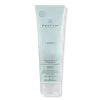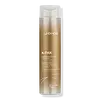What's inside
What's inside
 Key Ingredients
Key Ingredients

 Benefits
Benefits

 Concerns
Concerns

 Ingredients Side-by-side
Ingredients Side-by-side

Water
Skin ConditioningSodium Cocoyl Isethionate
CleansingCocamidopropyl Betaine
CleansingDisodium Laureth Sulfosuccinate
CleansingLaureth-23
CleansingLaureth-4
EmulsifyingTrimethylsiloxyamodimethicone
Sodium Lauryl Sulfoacetate
CleansingGlycol Distearate
EmollientPolyquaternium-10
Hedychium Coronarium Root Extract
MaskingCamellia Sinensis Leaf Extract
AntimicrobialCitrus Aurantifolia Peel Extract
CleansingKeratin
Skin ConditioningHydrolyzed Keratin
HumectantOxidized Keratin
Skin ConditioningHydrolyzed Wheat Protein
Skin ConditioningGlycerin
HumectantSodium Chloride
MaskingBioflavonoids
Skin ConditioningPolyquaternium-5
Sodium Sulfate
Guar Hydroxypropyltrimonium Chloride
Skin ConditioningDisodium EDTA
Magnesium Nitrate
Magnesium Chloride
Phenoxyethanol
PreservativeMethylchloroisothiazolinone
PreservativeMethylisothiazolinone
PreservativeParfum
MaskingLimonene
PerfumingBenzyl Salicylate
PerfumingHexyl Cinnamal
PerfumingLinalool
PerfumingWater, Sodium Cocoyl Isethionate, Cocamidopropyl Betaine, Disodium Laureth Sulfosuccinate, Laureth-23, Laureth-4, Trimethylsiloxyamodimethicone, Sodium Lauryl Sulfoacetate, Glycol Distearate, Polyquaternium-10, Hedychium Coronarium Root Extract, Camellia Sinensis Leaf Extract, Citrus Aurantifolia Peel Extract, Keratin, Hydrolyzed Keratin, Oxidized Keratin, Hydrolyzed Wheat Protein, Glycerin, Sodium Chloride, Bioflavonoids, Polyquaternium-5, Sodium Sulfate, Guar Hydroxypropyltrimonium Chloride, Disodium EDTA, Magnesium Nitrate, Magnesium Chloride, Phenoxyethanol, Methylchloroisothiazolinone, Methylisothiazolinone, Parfum, Limonene, Benzyl Salicylate, Hexyl Cinnamal, Linalool
Water
Skin ConditioningSodium Laureth Sulfate
CleansingSodium Chloride
MaskingCocamide Mea
EmulsifyingCocamidopropyl Betaine
CleansingPEG-3 Distearate
EmulsifyingDisodium Laureth Sulfosuccinate
CleansingHydrolyzed Keratin
HumectantHydrolyzed Keratin Pg-Propylmethylsilanediol
Skin ConditioningCocodimonium Hydroxypropyl Hydrolyzed Keratin
Skin ConditioningLaurdimonium Hydroxypropyl Hydrolyzed Keratin
Skin ConditioningArginine Hcl
Skin ConditioningPhosphatidylcholine
EmulsifyingRosa Canina Fruit Oil
EmollientAleurites Moluccanus Seed Oil
Skin ConditioningPsidium Guajava Fruit Extract
AstringentAloe Barbadensis Leaf Juice
Skin ConditioningOenothera Biennis Oil
EmollientTocopheryl Acetate
AntioxidantSodium Hyaluronate
HumectantGlycolipids
Skin ConditioningSodium Cocoamphoacetate
CleansingGuar Hydroxypropyltrimonium Chloride
Skin ConditioningPropoxytetramethyl Piperidinyl Dimethicone
Citric Acid
BufferingTrisodium Sulfosuccinate
BufferingSodium Cocoyl Glutamate
CleansingCetrimonium Chloride
AntimicrobialC11-15 Pareth-7
EmulsifyingTrideceth-6
EmulsifyingGlycerin
HumectantBenzophenone-4
UV AbsorberThioctic Acid
AntioxidantButyl Methoxydibenzoylmethane
UV AbsorberAllantoin
Skin ConditioningSodium Ascorbyl Phosphate
AntioxidantTetrasodium Glutamate Diacetate
Sodium Hydroxide
BufferingPhenoxyethanol
PreservativeSodium Benzoate
MaskingParfum
MaskingWater, Sodium Laureth Sulfate, Sodium Chloride, Cocamide Mea, Cocamidopropyl Betaine, PEG-3 Distearate, Disodium Laureth Sulfosuccinate, Hydrolyzed Keratin, Hydrolyzed Keratin Pg-Propylmethylsilanediol, Cocodimonium Hydroxypropyl Hydrolyzed Keratin, Laurdimonium Hydroxypropyl Hydrolyzed Keratin, Arginine Hcl, Phosphatidylcholine, Rosa Canina Fruit Oil, Aleurites Moluccanus Seed Oil, Psidium Guajava Fruit Extract, Aloe Barbadensis Leaf Juice, Oenothera Biennis Oil, Tocopheryl Acetate, Sodium Hyaluronate, Glycolipids, Sodium Cocoamphoacetate, Guar Hydroxypropyltrimonium Chloride, Propoxytetramethyl Piperidinyl Dimethicone, Citric Acid, Trisodium Sulfosuccinate, Sodium Cocoyl Glutamate, Cetrimonium Chloride, C11-15 Pareth-7, Trideceth-6, Glycerin, Benzophenone-4, Thioctic Acid, Butyl Methoxydibenzoylmethane, Allantoin, Sodium Ascorbyl Phosphate, Tetrasodium Glutamate Diacetate, Sodium Hydroxide, Phenoxyethanol, Sodium Benzoate, Parfum
Ingredients Explained
These ingredients are found in both products.
Ingredients higher up in an ingredient list are typically present in a larger amount.
Cocamidopropyl Betaine is a fatty acid created by mixing similar compounds in coconut oil and dimethylaminopropylamine, a compound with two amino groups.
This ingredient is a surfactant and cleanser. It helps gather the dirt, pollutants, and other impurities in your skin to be washed away. It also helps thicken a product and make the texture more creamy.
Being created from coconut oil means Cocamidopropyl Betaine is hydrating for the skin.
While Cocamidopropyl Betaine was believed to be an allergen, a study from 2012 disproved this. It found two compounds in unpure Cocamidopropyl Betaine to be the irritants: aminoamide and 3-dimethylaminopropylamine. High-grade and pure Cocamidopropyl Betaine did not induce allergic reactions during this study.
Learn more about Cocamidopropyl BetaineThis ingredient is a cleansing agent, surfactant, and foam booster. It considered an alternative to traditional sulfates (Sulfosuccinate) and is allowed in "sulfate-free" products.
According to a manufacturer, this ingredient is mild and can be used in baby and bath options.
Glycerin is already naturally found in your skin. It helps moisturize and protect your skin.
A study from 2016 found glycerin to be more effective as a humectant than AHAs and hyaluronic acid.
As a humectant, it helps the skin stay hydrated by pulling moisture to your skin. The low molecular weight of glycerin allows it to pull moisture into the deeper layers of your skin.
Hydrated skin improves your skin barrier; Your skin barrier helps protect against irritants and bacteria.
Glycerin has also been found to have antimicrobial and antiviral properties. Due to these properties, glycerin is often used in wound and burn treatments.
In cosmetics, glycerin is usually derived from plants such as soybean or palm. However, it can also be sourced from animals, such as tallow or animal fat.
This ingredient is organic, colorless, odorless, and non-toxic.
Glycerin is the name for this ingredient in American English. British English uses Glycerol/Glycerine.
Learn more about GlycerinThis ingredient is derived from guar gum.
It is a conditioning ingredient, meaning it helps soften skin and hair.
Hydrolyzed Keratin is derived from keratin. Keratin is a large protein that is naturally found in our hair and skin.
Studies show keratin is able to seal broken hair cuticles, helping to prevent split ends and breakage.
As a humectant, hydrolyzed keratin helps draw moisture from the air to your hair and skin. This helps keep your skin and hair hydrated.
Learn more about Hydrolyzed KeratinParfum is a catch-all term for an ingredient or more that is used to give a scent to products.
Also called "fragrance", this ingredient can be a blend of hundreds of chemicals or plant oils. This means every product with "fragrance" or "parfum" in the ingredients list is a different mixture.
For instance, Habanolide is a proprietary trade name for a specific aroma chemical. When used as a fragrance ingredient in cosmetics, most aroma chemicals fall under the broad labeling category of “FRAGRANCE” or “PARFUM” according to EU and US regulations.
The term 'parfum' or 'fragrance' is not regulated in many countries. In many cases, it is up to the brand to define this term.
For instance, many brands choose to label themselves as "fragrance-free" because they are not using synthetic fragrances. However, their products may still contain ingredients such as essential oils that are considered a fragrance by INCI standards.
One example is Calendula flower extract. Calendula is an essential oil that still imparts a scent or 'fragrance'.
Depending on the blend, the ingredients in the mixture can cause allergies and sensitivities on the skin. Some ingredients that are known EU allergens include linalool and citronellol.
Parfum can also be used to mask or cover an unpleasant scent.
The bottom line is: not all fragrances/parfum/ingredients are created equally. If you are worried about fragrances, we recommend taking a closer look at an ingredient. And of course, we always recommend speaking with a professional.
Learn more about ParfumPhenoxyethanol is a preservative that has germicide, antimicrobial, and aromatic properties. Studies show that phenoxyethanol can prevent microbial growth. By itself, it has a scent that is similar to that of a rose.
It's often used in formulations along with Caprylyl Glycol to preserve the shelf life of products.
Chances are, you eat sodium chloride every day. Sodium Chloride is also known as table salt.
This ingredient has many purposes in skincare: thickener, emulsifier, and exfoliator.
You'll most likely find this ingredient in cleansers where it is used to create a gel-like texture. As an emulsifier, it also prevents ingredients from separating.
There is much debate on whether this ingredient is comedogenic. The short answer - comedogenic ratings don't tell the whole story. Learn more about comegodenic ratings here.
The concensus about this ingredient causing acne seems to be divided. Research is needed to understand if this ingredient does cause acne.
Scrubs may use salt as the primary exfoliating ingredient.
Learn more about Sodium ChlorideWater. It's the most common cosmetic ingredient of all. You'll usually see it at the top of ingredient lists, meaning that it makes up the largest part of the product.
So why is it so popular? Water most often acts as a solvent - this means that it helps dissolve other ingredients into the formulation.
You'll also recognize water as that liquid we all need to stay alive. If you see this, drink a glass of water. Stay hydrated!
Learn more about Water